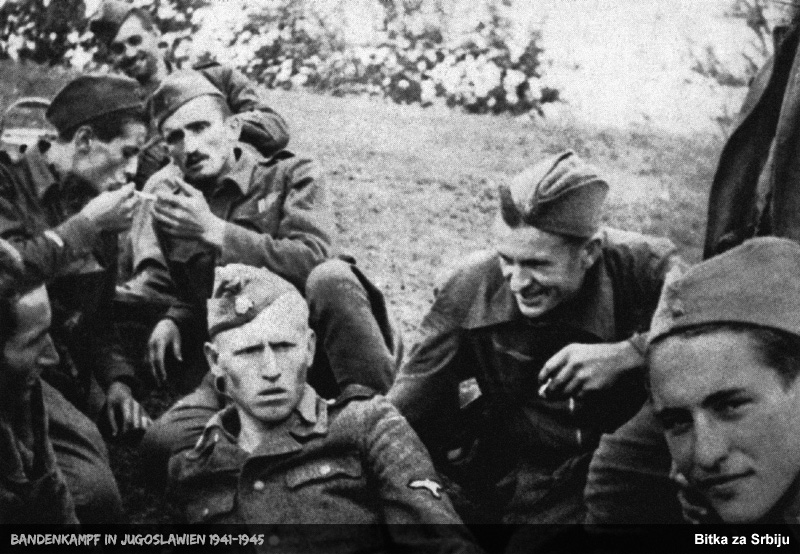
Looting at the Ostrog monastery. Members of Special Detachment Hintze (Gestapo) pose with the "Serbian treasure" (as the German propaganda
called it), found in the monastery storeroom. It is a part of the royal wealth that the king left the monks for safekeeping, when fleeing the country. Total value: 375 million dinars (10 chests of gold and 15 sacks of paper money). The Germans left with paper money and three chests of gold, while seven chests remained hidden; one of those seven was later taken by the Chetniks, five were taken by the new authorities (Partisans), and one was embezzled by the abbot of Ostrog, Leontije (which he later confessed himself, repenting sincerely). The Germans, naturally, did try to find the rest of the gold, and looted the monastery itself as well – twice; a statement by Hieromonk Vasilije Dragović (a quote from the book "Martyrdom of the Serbian Patriarch" by Velibor Džomić): "On [...] 25 April 1941, [...] they took from the monastery: carpets, blankets, various drinks, coffee, sugar, meat, clothes and some furniture. [...] On 1 May [...] they broke the door locks of the abbot's house, opened the safes, and took out (of the rooms and safes) anything they liked, for example – jewellery, carpets, clothes, socks, handkerchiefs, cups, utensils, cigarettes, matches, soap, meat, bacon, wine, rakia, petrol, coffee, sugar, jam, oil, in a word – everything they liked, they put in their vehicles. Additionally, they took me into the woods to show them the caves, where they searched for gold." (A couple of days later, the Italians also tried to plunder the monastery – without much success.) During the German "visit", there was an unusual encounter between the soldiers and the famous Serbian saint, Basil of Ostrog; a statement by the eyewitness Serafim Kašić, future abbot (from the aforementioned source): "When the soldiers saw the open casket and the saint, who rested in it, they stood at attention and paid their respects to the saint with a fascist salute. They stood like that for a while, and then, with great amazement and curiosity, approached closer to the saint and watched him, without touching anything with their hands." Posing in the photo are (from right to left): certain Friedrich (interpreter, in civilian clothes), SS-Sturmbannführer Karl Hintze (chief of the Gestapo unit), an unknown SS-Obersturmführer and Archimandrite Leontije Mitrović (abbot of Ostrog).
Text: Ivan Ž.
Photographer: Emil Grimm, 691st Propaganda Company.
Date: 25 April 1941.
Location: Ostrog (district of Danilovgrad), Yugoslavia.
Original caption: "Serbian state treasure in a rocky eyrie. During the search of the monastery, the Gestapo found a large part of Serbian treasure's millions in the storeroom, in which countless flitches of bacon, sausages and ham hang. Pictured on the left is the abbot, who had to get out of bed in the morning to reveal this hiding place."
File source: Nationaal Archief, SFA022804407.
NOT ALLOWED: removing source credits from the files – using text without crediting the original author – using files and information for political propaganda and commercial purposes.
Pljačka u manastiru Ostrogu. Pripadnici Specijalnog odreda Hince (Gestapo) poziraju sa "srpskim blagom" (kako ga je
nazvala nemačka propaganda), koje su pronašli u ostavi manastira. U pitanju je deo kraljevskog bogatstva koji je pri bekstvu iz zemlje kralj ostavio monasima na čuvanje. Ukupna vrednost: 375 miliona dinara (10 sanduka zlata i 15 vreća papirnog novca). Nemci su sa sobom odneli papirni novac i tri sanduka zlata, dok je sedam sanduka ostalo skriveno; jedan od tih sedam kasnije su uzeli četnici, pet je odnela nova vlast (partizani), a jedan je proneverio iguman ostroški, Leontije (što je kasnije, kajući se iskreno, sam priznao). Nemci su, naravno, bili pokušali da pronađu i ostatak zlata, a i sam manastir pljačkali – u dva navrata; izjava jeromonaha Vasilija Dragovića (citat iz knjige "Mučeništvo srpskog patrijarha" Velibora Džomića): "[...] 25. aprila 1941. godine, [...] pokupili su po manastiru: ćilime, ćebad, razna pića, kafu, šećer, meso, veša i ostalog namještaja. [...] 1. maja [...] su slomili brave na vratima nastojateljskog stana, otvorili kase i iz njih (soba i kasa) nosili sve što im se dopalo, npr. nakit, ćilime, veš, čarape, maramice, čaše, posuđe, cigarete, šibice, sapune, meso, slaninu, vino, rakiju, benzin, kafu, šećer, slatko, ulje, jednom riječju sve što im se dopalo, metnuli su u automobile. Uz to su mene vodili kroz šumu da im pokazujem pećine, u kojima su tražili zlato." (Par dana kasnije i Italijani su pokušali da pljačkaju manastir – bez većeg uspeha.) Za vreme nemačke "posete", desio se i neobičan susret vojnika sa čuvenim srpskim svetiteljem, Vasilijem Ostroškim; izjava očevica Serafima Kašića, budućeg igumana (iz prethodno pomenutog izvora): "Kad vojnici videše otvoren kovčeg i svetitelja, koji u njemu počiva, stadoše mirno i fašističkim pozdravom odaše poštu svetitelju. Tako malo postajaše, pa sa velikim čuđenjem i radoznalošću priđoše bliže svetitelju i posmatrahu ga, bez da što diraju rukama." Na fotografiji poziraju (zdesna nalevo): izvesni Fridrih (prevodilac, u civilu), SS-šturmbanfirer Karl Hince (šef gestapovske jedinice), nepoznati SS-oberšturmfirer i arhimandrit Leontije Mitrović (iguman ostroški).
Tekst: Ivan Ž.
Fotograf: Emil Grim, 691. propagandna četa.
Datum: 25. april 1941.
Mesto: Ostrog (srez Danilovgradski), Jugoslavija.
Originalni natpis: "Srpsko državno blago u kamenom gnezdu. Tokom pretresa manastira, Gestapo je u ostavi, u kojoj vise bezbrojni komadi slanine, kobasice i šunka, pronašao veliki deo miliona srpskog blaga. Levo na slici je iguman, koji je morao da ustane ujutru iz kreveta da bi otkrio ovo skrovište."
Izvor fajla: Nationaal Archief, SFA022804407.
NIJE DOZVOLJENO: uklanjanje naziva izvora sa fajlova – korišćenje teksta bez navođenja izvornog autora – korišćenje fajlova i informacija u političko-propagandne i komercijalne svrhe.













